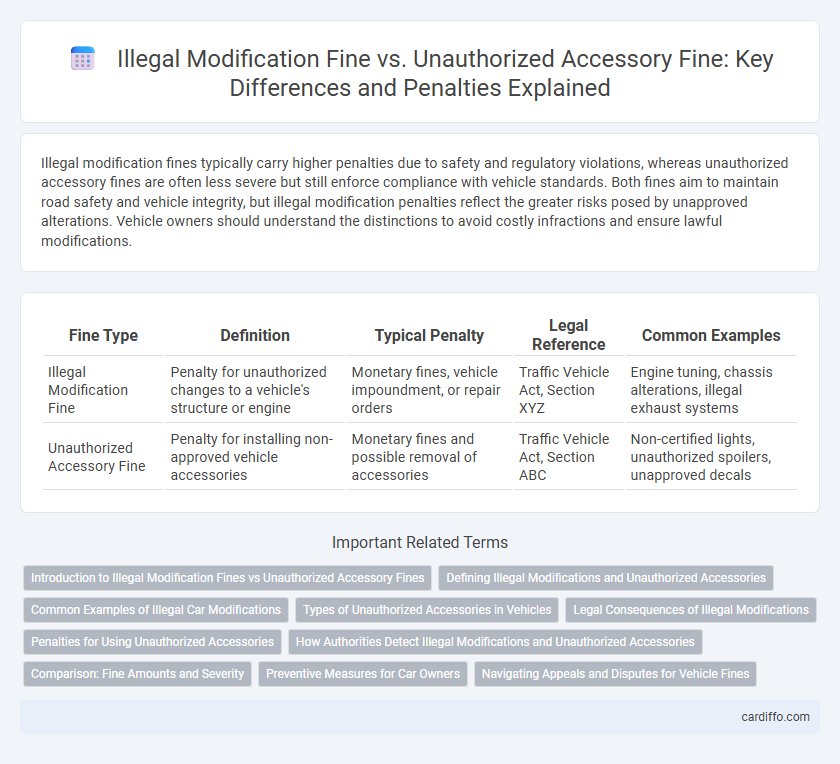Illegal modification fines typically carry higher penalties due to safety and regulatory violations, whereas unauthorized accessory fines are often less severe but still enforce compliance with vehicle standards. Both fines aim to maintain road safety and vehicle integrity, but illegal modification penalties reflect the greater risks posed by unapproved alterations. Vehicle owners should understand the distinctions to avoid costly infractions and ensure lawful modifications.
Table of Comparison
| Fine Type | Definition | Typical Penalty | Legal Reference | Common Examples |
|---|---|---|---|---|
| Illegal Modification Fine | Penalty for unauthorized changes to a vehicle's structure or engine | Monetary fines, vehicle impoundment, or repair orders | Traffic Vehicle Act, Section XYZ | Engine tuning, chassis alterations, illegal exhaust systems |
| Unauthorized Accessory Fine | Penalty for installing non-approved vehicle accessories | Monetary fines and possible removal of accessories | Traffic Vehicle Act, Section ABC | Non-certified lights, unauthorized spoilers, unapproved decals |
Introduction to Illegal Modification Fines vs Unauthorized Accessory Fines
Illegal modification fines target changes made to a vehicle that violate safety, emissions, or design regulations, often imposed by transportation authorities to ensure compliance with road standards. Unauthorized accessory fines pertain to penalties for installing accessories not approved or legal under vehicle equipment regulations, impacting vehicle safety or performance. Both fines aim to maintain road safety and environmental standards but differ in scope--modifications alter the vehicle's core functions, while unauthorized accessories refer to non-compliant add-ons.
Defining Illegal Modifications and Unauthorized Accessories
Illegal modifications refer to unauthorized changes made to a vehicle's structure, engine, or safety features that violate legal standards and can result in fines or penalties. Unauthorized accessories are non-approved additions or alterations to a vehicle's equipment, such as aftermarket parts or devices, that do not comply with regulatory guidelines and may also incur fines. Both illegal modifications and unauthorized accessories compromise vehicle safety and legality, leading to potential enforcement actions.
Common Examples of Illegal Car Modifications
Common examples of illegal car modifications include exhaust systems that exceed noise limits, tinted windows beyond legal opacity, and unauthorized engine tuning that bypasses emissions controls. These modifications often incur heavy fines, with illegal modification fines typically higher due to safety and environmental risks. Unauthorized accessory fines generally apply to non-compliant add-ons like oversized spoilers or non-approved lighting that violate vehicle standards.
Types of Unauthorized Accessories in Vehicles
Illegal modification fines typically apply to changes that alter a vehicle's original structure or performance, such as engine tampering or suspension lifting. Unauthorized accessory fines pertain to non-approved add-ons that may affect safety or emissions, including tinted windows exceeding legal limits, aftermarket lighting, or uncertified exhaust systems. Common unauthorized accessories include aggressive body kits, non-compliant alloy wheels, and roof racks installed without proper certification.
Legal Consequences of Illegal Modifications
Illegal modification fines impose significant legal penalties for altering a vehicle beyond approved specifications, often resulting in heavy monetary fines and potential vehicle impoundment. Unauthorized accessory fines target unapproved aftermarket parts, emphasizing compliance with safety and environmental regulations to prevent impaired vehicle performance. Both fines serve to enforce regulatory standards, deter hazardous modifications, and maintain public safety on roads.
Penalties for Using Unauthorized Accessories
Using unauthorized accessories on vehicles can lead to significant fines exceeding $500, emphasizing strict enforcement of illegal modification regulations. Penalties for illegal modifications often include increased fines, potential vehicle impoundment, and mandatory rectification orders. Authorities prioritize public safety and compliance, imposing harsher consequences for accessories that compromise vehicle standards or road safety.
How Authorities Detect Illegal Modifications and Unauthorized Accessories
Authorities detect illegal modifications and unauthorized accessories through comprehensive vehicle inspections using advanced diagnostic tools and visual assessments. They analyze discrepancies between vehicle specifications and factory standards, cross-referencing registration data with equipment regulations to identify non-compliant alterations. Enforcement agencies also utilize automated license plate recognition and public reporting systems to pinpoint vehicles exhibiting unauthorized changes.
Comparison: Fine Amounts and Severity
Illegal modification fines generally carry higher penalties compared to unauthorized accessory fines due to the potential safety risks and regulatory violations involved. Illegal modifications can result in fines ranging from $500 to over $2,000, reflecting the severity of altering vehicle structure or emissions systems. Unauthorized accessory fines are typically lower, often between $100 and $500, since accessories usually pose less immediate threat to safety or compliance.
Preventive Measures for Car Owners
Car owners should regularly inspect their vehicles to ensure compliance with legal standards and avoid illegal modification fines by using certified parts and following manufacturer guidelines. Installing only authorized accessories reduces the risk of unauthorized accessory fines, while consulting professional installers guarantees adherence to regulations. Keeping documentation of all modifications and accessories helps demonstrate compliance during inspections and police checks.
Navigating Appeals and Disputes for Vehicle Fines
Navigating appeals for illegal modification fines requires detailed evidence of compliance with vehicle standards, while unauthorized accessory fines focus on proving the accessory's legality under local regulations. Vehicle owners should meticulously review the specific breach cited, gather technical documentation, and consult automotive compliance experts to strengthen dispute cases. Understanding jurisdictional differences in enforcement policies enhances the likelihood of successful appeals against both illegal modification and unauthorized accessory penalties.
Illegal modification fine vs Unauthorized accessory fine Infographic

 cardiffo.com
cardiffo.com